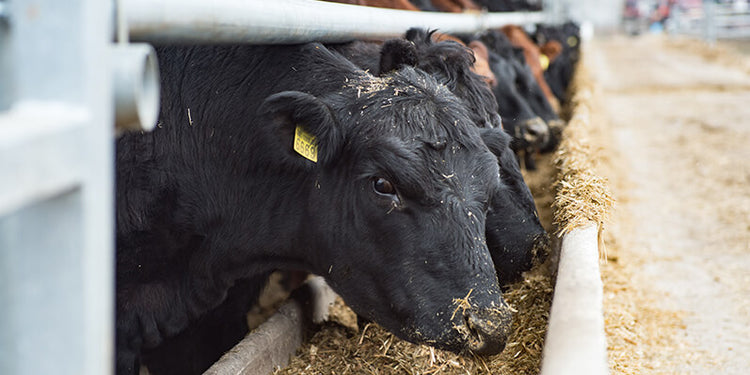What Are Byproducts?
Byproducts makeup a large poultry ration and about one-seventh of the ration for growing and fattening swine in the United States. They are also important in feeding beef and dairy cattle. Almost every food industry furnishes some byproducts for animal feed, but the most important sources are the milling of grain, the processing of oilseeds, the fermentation of grains and molasses, the manufacture of dairy products, and the slaughter of meat animals. The byproduct feeds discussed* here have been grouped for convenience according to their origin.
By products are produced from the production of another item/food, with the primary product often being for human use or consumption. For example, dried distillers grains, or DDG, come from the production of ethanol. Wheat midds come from the production of flour. Other by-products come from animal production, for example, chicken litter can be fed to cattle, and is very high in protein. Something has to be done with these secondary products, and it turns out they have great application in agriculture! With so many types of by-products, it can be difficult to know the primary role of each in animal nutrition. Here’s some quick ways to know what each product can do for your nutritional program.
Meal
Meal feeds are a by-product of oil extraction. Oils are high in fat, which is a form of energy, leaving high levels of protein behind once the oil is removed. Meal products can come from plant sources, such as soybeans and cottonseed, or from animal sources, including meat & bone meal and blood meal.
Hulls & Pulp
Hulls and pulp are the outer portion of the seed or fruit and are very high in fiber. While these are often mistaken as fillers, hulls and pulp products are extremely useful when forages are limited.
Distillers Grains
Distillers grains are in a league of their own, being high in both protein and energy. Most feeds are high in one or the other, but high concentrations of oil left behind when starch is removed from the corn kernel allows distillers grains to contain high energy, as well as protein. Distillers grains can come in 3 main forms, dried, modified wet, and wet, while dried distillers grains, also known as DDG, are the most commonly used, since they can be hauled further and are more consistent in dry matter and nutrient content.
Midds
Midds are produced when wheat is cleaned for the production of flour and tend to be relatively safe due to the removal of starch during flour production. Wheat midds used to be known as “floor screenings,” but are now identified as a valuable feed source due to its mid-level protein content and high digestibility.
Molasses
Molasses comes from the production of sugar for human consumption. It is frequently used to increase palatability, and therefore consumption, as well as decrease dust in dry rations.
Additional Notes
Producing byproducts from removing another portion of the feed leaves behind high concentrations. While this can be beneficial, in cases of protein and energy, it can also be dangerous. For example, high levels of phosphorus, calcium, or cottonseed products, gossypol can be left in high concentrations. While these can be harmless, and even beneficial, in small amounts, too much can pose a threat to animal health and should be considered when forming nutritional programs.
As time goes on, more and more research is being conducted on the efficacy of byproducts in animal nutrition. Secondary products considered as "waste" products only 40 years ago are now proving themselves to be some of the most profitable feeds in the business. While each feed source has its own set of pros and cons, byproducts should not be overlooked in your nutritional program.
How can you get even more out of your byproducts?
The answer is simple: Nutri-Zyme®.
This all-natural prebiotic top dress is designed to promote feed intake and improve vigor, thereby leading to overall improved health and gain. In addition, Nutri-Zyme® has shown to treat cases of scours and bloat, so your calves can get the most out of their feed. (Check out this blog to learn more about Ruminant Nutrition Basics)
Contact a rep to learn more about adding adding NutriZyme® into your nutritional program.
 Order Now Contact a Representative
Order Now Contact a Representative
Check out what one grower had to say…
“I started using NutriZyme® about one and a half years ago. At that time, I was becoming concerned about the limited use of antibiotics. Some of the issues I was facing… birds going off feed at 3-4 weeks old, my mortality was going up, and the birds were very sizey. This last issue continued until market time creating birds that weighed anywhere from 8 - 16 lbs. We began by spraying the feedlines with NutriZyme®. We observed that the birds responded very well to the product and we started to see fewer gut issues in the birds. With less gut issues and the birds not going off feed, this meant more profit at settlement time. Having seen positive results from the NutriZyme® feed additive, we also began to treat the litter with IndigoLT®. This treatment was to reinforce the placement of good enzymes in the birds’ environment, while slowing the ammonia and keeping the litter dryer. At this time, both products are in use with positive results in bird performance and profit in the flock settlements. Also, I have not had to use any antibiotics in the last year.”
Sources:
"Byproducts" 2012 Association of American Feed Control Officials


